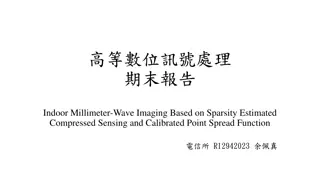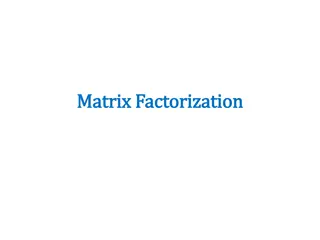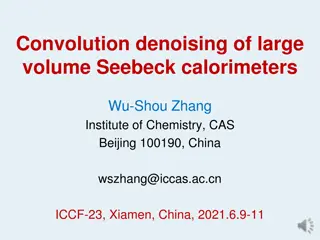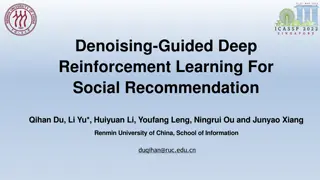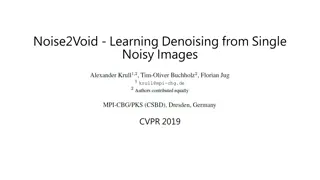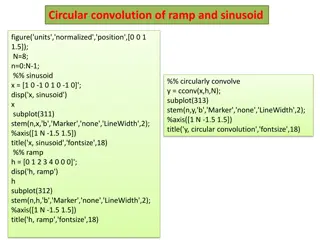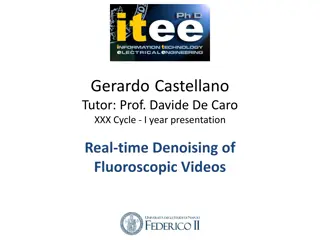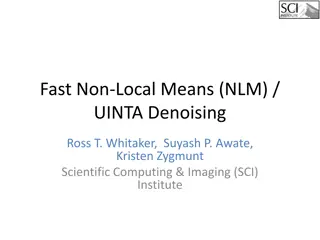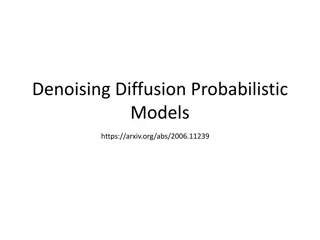Autoencoders: Applications and Properties
Autoencoders play a crucial role in supervised and unsupervised learning, with applications ranging from image classification to denoising and watermark removal. They compress input data into a latent space and reconstruct it to produce valuable embeddings. Autoencoders are data-specific, lossy, and
2 views • 18 slides
Sparse Millimeter-Wave Imaging Using Compressed Sensing and Point Spread Function Calibration
A novel indoor millimeter-wave imaging system based on sparsity estimated compressed sensing and calibrated point spread function is introduced. The system utilizes a unique calibration procedure to process the point spread function acquired from measuring a suspended point scatterer. By estimating
4 views • 26 slides
Matrix Factorization for Latent Factor Recovery
Explore the concept of matrix factorization for recovering latent factors in a matrix, specifically focusing on user ratings of movies. This technique involves decomposing a matrix into multiple matrices to extract hidden patterns and relationships. The process is crucial for tasks like image denois
2 views • 50 slides
Advanced Convolution Denoising Techniques for Large-Volume Seebeck Calorimeters
Cutting-edge research on convolution denoising methods for Seebeck calorimeters to reduce noise levels caused by temperature fluctuations. The study explores hardware design, mathematical principles, and examples of denoising applications, aiming to enhance measurement accuracy and stability in larg
1 views • 10 slides
Denoising-Oriented Deep Hierarchical Reinforcement Learning for Next-basket Recommendation
This research paper presents a novel approach, HRL4Ba, for Next-basket Recommendation (NBR) by addressing the challenge of guiding recommendations based on historical baskets that may contain noise products. The proposed Hierarchical Reinforcement Learning framework incorporates dynamic context mode
2 views • 16 slides
Denoising-Guided Deep Reinforcement Learning for Social Recommendation
This research introduces a Denoising-Guided Deep Reinforcement Learning framework, DRL4So, for enhancing social recommendation systems. By automatically masking noise from social friends to improve recommendation performance, this framework focuses on maximizing the positive utility of social denois
0 views • 15 slides
Innovative Denoising Techniques and Limitations
Examination of Noise2Void, Noise2Noise, and Traditional Denoising Models in image processing, highlighting their unique approaches and challenges. Implementations details, experiments, limitations, and comments are discussed, showcasing the potential and shortcomings of these techniques in denoising
5 views • 8 slides
Circular Convolution of Ramp and Sinusoid
Circular convolution of a ramp signal and a sinusoid, followed by convolving a rectangular pulse with itself for exploring convolution techniques. The process involves visualizing signal convolutions, understanding how zero-padding affects plotting clarity, and using convolution for denoising a piec
41 views • 4 slides
Earthquake Prediction Using Acoustic Data
Earthquakes can have devastating impacts, both in terms of financial losses and loss of life. Predicting earthquakes using seismographic acoustic data can help mitigate these impacts by enabling timely response systems. This research explores utilizing machine learning models to predict time-to-fail
1 views • 18 slides
Mahmoud El-Sakka - Computer Science Research & Teaching
Mahmoud El-Sakka is a prominent figure in the field of computer science, focusing on image denoising, compression, and prediction methods. He is known for his expertise in digital image processing and offers a course on digital image compression at the University of Western Ontario.
0 views • 9 slides
Real-time Denoising of Fluoroscopic Videos by Gerardo Castellano
Gerardo Castellano, a tutor under Prof. Davide De Caro in the XXX Cycle - I year presentation, focuses on real-time denoising of fluoroscopic videos. With a background in Electronic Engineering from the University of Napoli Federico II, Castellano's research activities primarily revolve around VLSI
0 views • 11 slides
Predicting Earthquakes with Machine Learning and Acoustic Data
Earthquakes can have devastating impacts, making it crucial to predict and prepare for them. Utilizing seismographic acoustic data and modern machine learning techniques, such as Random Forests models, can help in forecasting the time-to-failure of earthquakes. The LANL Dataset provides valuable aco
0 views • 18 slides
Fast Non-Local Means (NLM) and UINTA Denoising Techniques
Learn about Fast Non-Local Means and UINTA denoising methods for image processing within ITK framework. Explore aims including computational efficiency, noise models, and project status with code design and implementation.
2 views • 25 slides
Real-Time Exemplar-Based Face Sketch Synthesis Pipeline
Learn about a real-time exemplar-based face sketch synthesis pipeline that utilizes photo-sketch pairs and advanced algorithms for sketch denoising, including Coarse Sketch Generation and Proposed Spatial Sketch Denoising Algorithm (SSD).
4 views • 9 slides
Probabilistic Models for Denoising Diffusion - Research Explained
Explore the world of denoising diffusion probabilistic models with a detailed outline covering introduction, method, experiments, and conclusions. Learn about the training objectives, network architecture, and achieved results in image generation. Discover the potential for future research and impro
0 views • 12 slides
Deep Similarity Learning for Multimodal Medical Images
Explore how deep neural networks are utilized to learn similarity metrics for uni-modal/multi-modal medical images in the context of image registration and clinical applications. Methods such as fully connected DNNs and stacked denoising autoencoders are discussed, emphasizing the importance of effe
1 views • 19 slides
Understanding Autoencoders: A Deep Dive into Unsupervised Learning
Explore the world of autoencoders, a powerful tool in unsupervised learning, where networks learn to encode and decode data without explicit labels. Discover how autoencoders revolutionize image classification and applications like denoising, colorization, and watermark removal, with a focus on stru
3 views • 18 slides
Explore Difference Between Denoising and No Denoising in Particle Physics Analysis
Discover the impact of denoising on particle physics analysis through comparing runs with and without denoising across different categories. Analyze momentum and missing mass squared distributions to understand the differences in signal yields.
0 views • 6 slides
Mahmoud El-Sakka - Computer Science Research Interests and Teaching
Explore Mahmoud El-Sakka's research interests in image denoising and compression, along with details on his teaching of CS4481b/CS9628b on image compression. Learn about his work in reducing noise in digital images and encoding information using fewer bits.
2 views • 8 slides
Mahmoud El-Sakka - Computer Science Research Interests
Explore Mahmoud El-Sakka's research interests in image denoising, image compression, prediction methods, and teaching Image Compression courses in the Computer Science Department at University of Western Ontario. Get insights into his work and expertise in reducing noise in digital images and encodi
0 views • 8 slides

